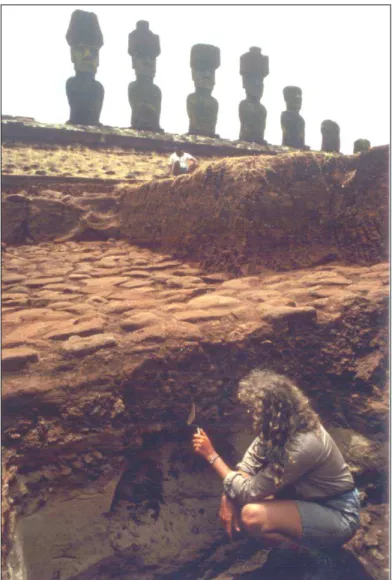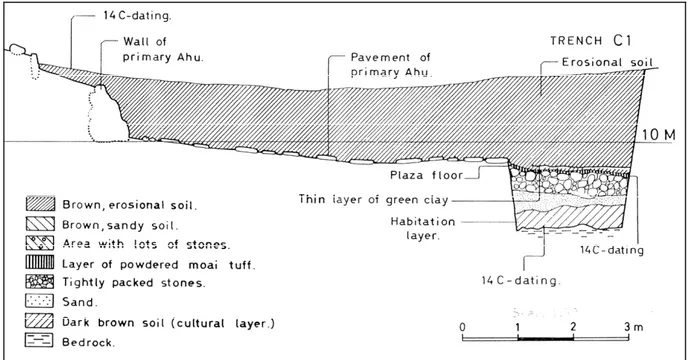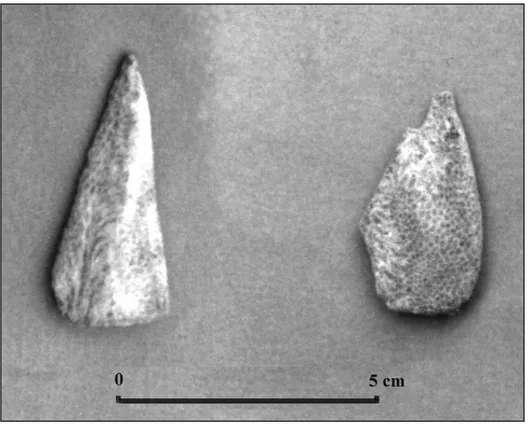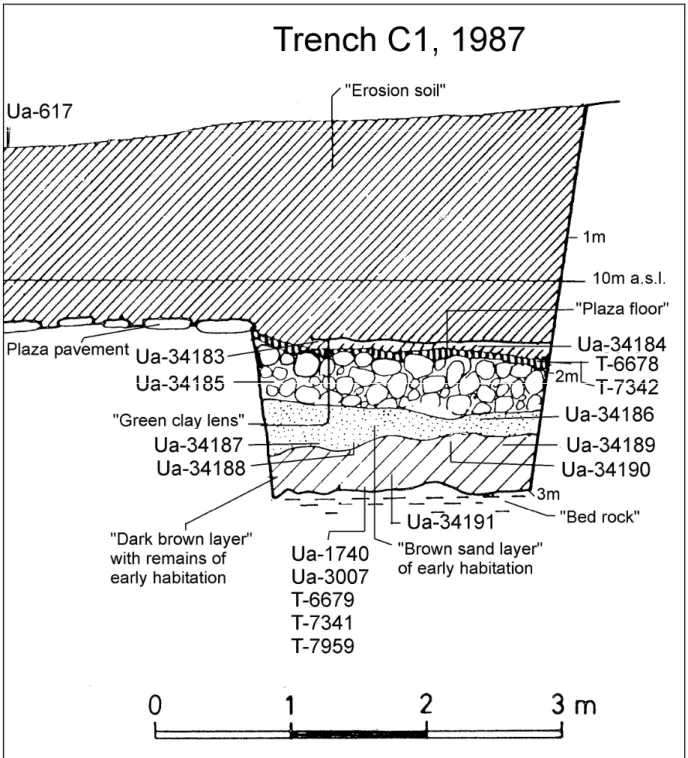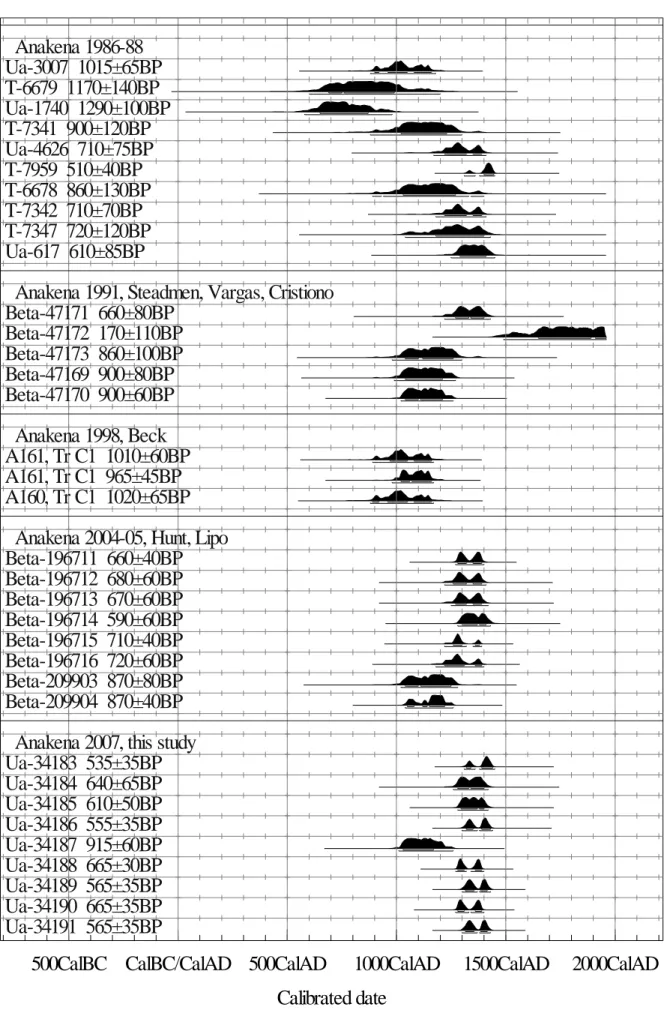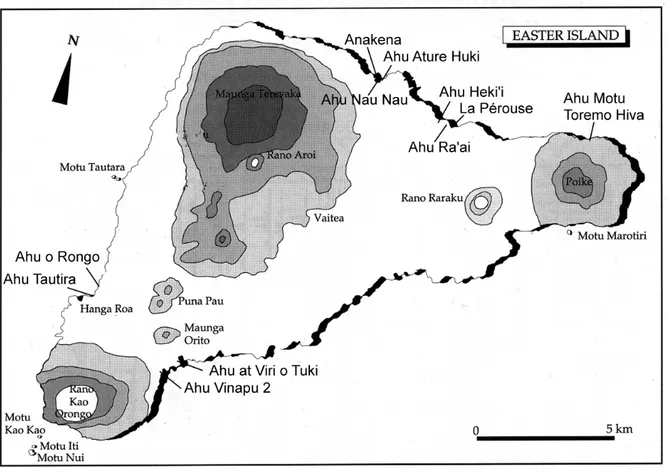37
Re-dating Ahu Nau Nau and the Settlement at
‘Anakena, Rapa Nui
Paul Wallin, Helene Martinsson-Wallin
Gotland University, Sweden
Göran Possnert
Uppsala University, Sweden
Abstract - The building phase and early use of Ahu Nau Nau have been re-dated by nine charcoal and rat bone samples. The new dates in comparison with earlier data suggest that the ahu was constructed around 650-550 BP. It is also suggested that a settlement dated to c. 950-900 BP preceded the ahu-building phase. A new question in light of recent research might be raised: Is the earliest settlement on Rapa Nui found at ´Anakena or should we look elsewhere?
Introduction
The ´Anakena site is located in a protected bay with a sandy beach on the north coast of Rapa Nui. Oral traditions indicate that the site was the residence of high chiefs of the Miru clan, and it is mentioned as the landing place of the first high chief, Hotu Matu´a (Métraux 1940:133).The last high chief, Nga´ara, who died just before the Peruvian slave raid in the 1860s, had his residence at ´Anakena (Routledge 1919:241-242). Subsequent chiefs lived at a place named Ahu-akapu, located near Tahai, which is close to the present village of Hanga Roa (Métraux1940:132).
This paper discusses temporal issues in relation to the ahu structures and settlement sites at ´Anakena, especially focusing on dated charcoal samples and their provenance. Excavations in the area have been carried out mainly under the leadership of Arne Skjølsvold and Thor Heyerdahl in 1986-88 (Skjølsvold 1994). In 1991, David Steadman, Patricia Vargas, and Claudio Cristino carried out minor excavations on the seaside of Ahu Nau Nau (Steadman et al. 1994), and in 2004-2005 Terry Hunt and Carl Lipo excavated in the sand dunes closer to the sea (Hunt & Lipo 2006). All dates referred to in this paper are calibrated using CALIB (Version 5.0.1.) with the SHCal04 calibration data set.
´Anakena 1986-88 Excavations by Arne Skjølsvold and Thor Heyerdahl
Skjølsvold’s excavations revealed that the earliest cultural remains at ´Anakena, were found close to the bedrock below three meters of erosion soil on the inland side of the main Ahu Nau Nau. According to Skjølsvold these remains were dated to “somewhere around AD 1000” or the primary settlement could not be “older than AD 800 or younger than AD 1000” (1994:107). He concluded (1994:107) that “a date around AD 1200 or a little earlier should be justifiable for the primary phase” for Ahu Nau Nau. These interpretations were based mainly on results of the excavation of the main trench (C1) located on the south side in front of the restored Ahu Nau Nau (Figure 1 & 2). The analyzed charcoal samples originated from a dark brown clayey cultural layer found at the bottom of the trench close to the bedrock at a depth of ca 2.6-3.0 m from the present surface level as well as from selected contexts dating the building phases of the ahu structure. The samples listed in Table 1 below have been dated at the Trondheim 14C laboratory and at the AMS 14C laboratory at Uppsala.
The sample provenance tied to Ahu Nau Nau shows that the latest phase at Ahu Nau Nau (called phase III) is dated by a sample collected just at the top of the ahu of the primary structure (phase I ahu), level with the plaza floor of the present and restored ahu. The sample (Ua-617) is dated to 610 ± 85 BP (AD 1272-1478 cal. at 2 Sigma). Here small fragments of charcoal were found among a concentration of yellowish stone powder that probably originated from the dressing of the moai.
38
Lab no Site Material BP Value Age (AD) cal. at 2 sigma
T-6679 Settlement (Charcoal) 1170 ± 140 657-1180 Ua-3007 Settlement (Rat bone) 1015 ± 65 967-1214 Ua-1740 Settlement (Marine sample) 1290 ± 100 900- 1270* T-7341 Settlement (Charcoal) 900 ± 120 975-1390 Ua-4626 Settlement (Rat Bone) 710 ± 75 1223-1412 T-7959 Settlement (Charcoal) 510 ± 40 1399-1482 T-6678 Ahu Nau Nau (Charcoal) 860 ± 130 992-1396 T-7342 Ahu Nau Nau (Charcoal) 710 ± 70 1228-1407 T-7347 Ahu Nau Nau (Charcoal) 720 ± 120 1048-1455 Ua-617 Ahu Nau Nau (Charcoal) 610 ± 85 1272-1478
*= Marine calibration
The charcoal is therefore suggested to be contemporary with this activity. The sample (T-7347) found on the plaza floor in a trench a few meters to the west of trench C1 was detected in a closed context of gray basalt stone powder and pebbles, indicating stone work on the plaza in front of the wall. The sample gave a date of 720 ± 120 BP (AD 1048-1455 cal. at 2 Sigma) and is interpreted to date the phase II structure (Skjølsvold 1994:28). The charcoal sample is interpreted as contemporary with the stone work activity. The sample (T-6678) found in trench C1 c. 150 cm below the current plaza, in the soil between courtyard stones of the primary ahu, yielded a date of 860 ± 130 BP (AD 992-1396 cal. at 2 Sigma). A second sample of the primary ahu (T-7342) was collected from a feature in the plaza located just in front of the ahu wall. The feature was c. 80 × 40 cm in size, consisting of fist-sized stones mixed with small pieces of charcoal; the sample yielded a date of 710 ± 70 BP (AD 1228-1407 cal. at 2 sigma). These two samples were interpreted to date the courtyard of the primary phase
Figure 1. Helene Martinsson-Wallin during Excavations of Trench C1 at ´Anakena in 1987.
39
of Ahu Nau Nau. Evaluating the sample (T-7347), interpreted as dating the phase II construction, shows a wider range when calibrated than the sample (T-7342) dating the primary structure. Even if the former sample shows a wider range than the latter, the stratigraphy suggests the former to be tied to an earlier activity. When considering the dates of the samples and their provenance we suggest that it is safe to say the results at least show the primary ahu is dated to sometime before AD 1400 and that the stratigraphy showed at least three different building phases.
The samples from the cultural layer below the primary ahu phase all derived from the dark brown culture layer found at a depth of c. 2.6-3.0 m from present surface. The charcoal samples have not been subjected to botanical identification and show wide standard errors. The rat bone sample (Ua-3007) dated to 1015 ± 65 BP (cal. at 2 Sigma to AD 967-1214) is suggested to be the most reliable sample and the three samples T-6679, Ua-1740, and T-4341 indicate dates around 1000 ± 100 BP. Two of the samples from the bottom layer, Ua-4626 and T-7959, indicate intrusions several hundred years younger. Our final conclusion is that the ahu phases and cultural activities found at ´Anakena, needed to be re-dated. This paper presents a new dating sequence on material excavated in 1986-88 carried out in 2007 at the Svedberg AMS Laboratory, Uppsala. Additional dating results from ´Anakena site carried out by other researchers are also compiled and evaluated.
Projects by David Steadman, Patricia Vargas and Claudio Cristino (1991),
Warren Beck (1998), Terry Hunt and Carl Lipo (2004-2005)
Other archaeological projects dealing with the chronology at ´Anakena also suggest the earliest dated activity be set to around 1000-900 BP. The excavation of a single trench by Steadman, Vargas and Cristino, carried out with the aim to mainly study extinctions among birds, was located at the sea side of Ahu Nau Nau. A stratigraphic sequence with related charcoal samples were dated see Table (Steadman et al. 1994):
Lab no Site Material BP Value Age (AD) cal. at 2 sigma
Beta-47171 Settlement Upper Charcoal 660 ± 80 1236-1445 Beta-47172 Settlement Upper Charcoal 170 ± 110 1510-1956 Beta-47173 Settlement Upper Charcoal 860 ±100 1023-1386 Beta-47169 Settlement bottom Charcoal 900 ± 80 1027-1283 Beta-47170 Settlement bottom Charcoal 900 ± 60 1042-1274
Figure 2. Drawing of Trench C1, 1987 (from Skjølsvold 1994:15).
40
The three dated samples Beta-47169, Beta-47170, and Beta-47173 fall in the time frame around 760-980 BP, which support the previous indications of the early cultural layer found in trench C1. The sample Beta-47171 suggests a subsequent activity, probably tied to the building phase of Ahu Nau Nau sometime around AD 1300-1400, which also is in line with the interpretation by Skjølsvold (1994).
Warren Beck of the University of Arizona AMS 14C dating laboratory, carried out a dating project on coral artefacts, such as statue eye fragments and files found in excavations at ´Anakena. A total of twenty-seven samples were dated. A marine reservoir correction of 320 years was determined by 14C measurements on modern pre-bomb-pulse corals (Warren Beck, pers. comm., March 22, 1999; Beck, Hewitt et al. 2003). Seven of the samples were dated to the time frame 1020-901 BP, eight samples were dated around 900-701 BP, four samples were dated around 700-501 BP, and seven to around 500-400 BP. One sample came out considerably earlier at 1325 BP and has been interpreted as erroneous or suggests old coral used to make the artefact. The samples and dates of coral files found at the bottom of the early settlement of trench C1 is shown in Table 3.
Cat no Site Material BP Value Marine cal. Age (AD) at 2 sigma
A161 Tr. C Early settlement Coral file 1010 ± 60 987-1204 A161 Tr. C Early settlement Coral file 965 ± 45 1029-1207 A160 Tr. C Early settlement Coral file 1020 ± 65 973-1212
Two samples were dated from the same file (Cat. no A161, Figure 3) one to around 1000-950 BP and the second to around 1000 BP, which again support previous dating results of samples from the cultural activity in the bottom of trench C1. The most recent excavation project at ´Anakena was carried out by Terry Hunt and Carl Lipo (Hunt & Lipo 2006; Hunt 2006). They excavated five units in an area about 30-60 m to the north of Ahu Nau Nau towards the sea. The excavation in the sand dune recovered several horizons that were dated from unit 1 and 5, by the following charcoal samples shown in Table 4.
Figure 3. The two dated coral files A160 and A161.
41
Lab no Site Material BP Value Age (AD) cal. at 2 sigma
Beta-196711 Settlement Charcoal 660 ± 40 1294-1403
Beta-196712 Settlement Charcoal 680 ± 60 1274-1414
Beta-196713 Settlement Charcoal 670 ± 60 1291-1400
Beta-196714 Settlement Charcoal 590 ± 60 1300-1450
Beta-196715 Settlement Charcoal 710 ± 40 1279-1391
Beta-196716 Settlement Charcoal 720 ± 60 1229-1400
Beta-209903 Settlement Charcoal 870 ± 80 1029-1372
Beta-209904 Settlement Charcoal 870 ± 40 1055-1278
The top six samples in the table above, reflect a time frame of around AD 1300-1400. The two samples at the bottom of the list reflect an earlier activity quite in line with the 900 BP (c. AD 1000-1300) dates presented by Skjølsvold (1994) and Steadman et al. (1994). In evaluating dated samples from early human activities in Rapa Nui, Hunt and Lipo (2006) suggest chronometric hygiene be used. Accepted samples included samples from their ´Anakena excavation, but only three previously dated samples from ´Anakena are, according to Hunt and Lipo, approved by the hygiene protocol. In addition three samples from an agricultural site were used, making up a total of eleven accepted samples from early contexts. Using this method Hunt and Lipo (ibid.) estimated the earliest Rapa Nui settlement so far to be around AD 1200. They are not dealing with the dating of the ahu structures in ´Anakena, but Hunt (2006:419) argues that “it also appears that the Islanders began building moai and ahu soon after reaching the island”. This interpretation is not in favor of a local development of ahu during the first settlement phase on the island, which means that a quite developed ahu feature were brought to the island, however there are so far no such developed structures in East Polynesia securely dated to that period.
Results of the 2007 Re-dating Project
In an effort to solve problems relating to the dating of the earliest ahu and settlement at ´Anakena we selected nine new samples from previously excavated dateable material stored at the Kon-Tiki Museum, Oslo. The samples were submitted to the AMS laboratory at Uppsala University, which was involved in the dating of some of the earlier samples carried out from the same trench. The newly submitted samples were mainly from rat bones and nut shells as well as three samples of unidentified charcoal from secure contexts. The selected samples were expected to solve the following problems:
Problem 1: Dating of Ahu Nau Nau and its construction phase.
Samples Ua-34183, Ua-34184 and Ua-34185 were expected to date the construction and use phase of the ahu structure (Nau Nau I) found below the present Ahu Nau Nau (Nau Nau III), which may have implications for the general temporal status of ahu structures on the island. Sample Ua-34183, consists of a nut shell from the palm tree (Paschalococos disperta), found between two distinct layers, which therefore is of great importance. Sample Ua-34184 is a pelvis from a Polynesian rat (Rattus exulans), also found in the same find context as the above mentioned sample. Sample Ua-34185 is a femur from an adult Rattus exulans, found in the mixed sand and stone layer below the plaza floor of Nau Nau I. This layer is interpreted as being constructed to facilitate drainage during this phase of the ahu. These three samples are thought to date the construction / early use phase of this
ahu.
Problem 2: Dating the initial settlement layer at ´Anakena. The layer was labeled the ”Dark brown layer” at the excavation in 1987. The layer rested on the bedrock. This might be the earliest settlement activity so far found on the island.
Sample 34189, 34190 and 34191 are expected to date the earliest settlement at ´Anakena. Sample Ua-34189 is a charred nut shell (Paschalococos disperta), found at the bottom of a charcoal concentration, situated in the upper part of the Dark brown layer. Sample Ua-34190 is a general charcoal sample from the upper part of the layer. The wood has no botanic determination, but was used to compare with the former sample. A third and additional sample Ua-34191 is from a nut shell (Paschalococos disperta) found at the bottom of the Dark brown layer.
42
Problem 3: Investigating the settlement layer located in the sand layer on top of the dark brown layer, and under the drainage layer. This layer was called “Brown Sand Layer” during the excavations in 1987.
Samples Ua-34186, Ua-34187 and Ua-34188 are expected to date an activity in the area just prior to the building of the first ahu (Nau Nau I). Sample Ua-34186 consists of general charcoal found in a charcoal concentration indicating a specific activity that took place at the spot in this layer but not identified to wood specie. Sample Ua-34187 is a femur from an adult Polynesian rat, Rattus exulans, found towards the bottom of this layer. Sample Ua-34188 derives from charcoal found in the layer, but it is not determined to wood species. The results of the 2007 re-dating project are shown in Table 5.
43
Lab no Site Material BP Value Age (AD) cal. at 2 sigma
Ua-34183 Ahu use Nut shell 535 ± 35 1400-1452 Ua-34184 Ahu use Rat bone 640 ± 65 1285-1433 Ua-34185 Ahu Construction Rat bone 610 ± 50 1300-1439 Ua-34186 Settl./Construction Charcoal 555 ± 35 1330-1452 Ua-34187 Settlement Rat bone 915 ± 60 1040-1267 Ua-34188 Settlement Charcoal 665 ± 30 1298-1397 Ua-34189 Settlement Nut shell 565 ± 35 1326-1448 Ua-34190 Settlement Charcoal 665 ± 35 1295-1399 Ua-34191 Settlement Nut shell 565 ± 35 1326-1448
Interpretation of Re-dating of Trench C1
The main trench C1 excavated in front of Ahu Nau Nau shows a distinct stratigraphy which we have made an effort to re-date. The result of the re-dating of samples tied to distinct stratigraphic contexts suggests that the stratigraphy is the result of quite rapid actions in the area during the construction and early use phase of the structure. The ahu construction and settlement phase found below the ahu, show similar dates to the construction phase of the ahu except one dated rat bone sample indicating an earlier date. We interpret this as the settlement layer found at the bottom of the trench was disturbed during the building of the first ahu with intrusions of later material. During the construction, large stones were moved around and sand and stones were brought in as drainage materials; and on top of this a hard packed earth floor was constructed. One of the re-dated samples Ua-34187, (915 ± 60 BP), shows a date in line with a previously dated rat bone sample found in the dark brown clay and with the coral files found in the same layer. It also shows contemporaneousness with two of the dated samples found by Steadman et al. (1994) in a trench on the sea side of the ahu and two dated samples by Hunt and Lipo (2006) also indicate an early human activity at ´Anakena that falls into the time period 800-1000 BP or AD 1000-1300 (calibrated 2 sigma). The construction phase of Ahu Nau Nau is by the re-dated samples suggested to be set to the time period 650-550 BP or AD 1300-1450 (calibrated 2 sigma).
The Island Context
Placing ´Anakena in a wider Island context, the re-dating of the initial phase of Ahu Nau Nau is not exceptionally early, but actually slightly later than a few other newly dated ahu sites. The distribution of ahu sites dated to the same time frame is found all around the island:
• Ahu Ature Huki (Skjølsvold 1994:106), secondary ahu at ´Anakena, N-coast, 2 samples c. 580-510 BP. • Ahu Heki´i (Martinsson-Wallin & Wallin 1998:85), primary ahu at La Pérouse, NE-coast, 2 samples c.
705-700 BP.
• Ahu Ra´ai (Martinsson-Wallin & Wallin 1998:85), secondary ahu at La Pérouse, NE-coast, 2 samples 570-515 BP.
• Ahu at Viro o Tuki, South coast (Hyuge & Cauwe 2005:8), 3 samples at 650-640 BP.
• Ahu Motu Toremo Hiva (Hyuge, Cauwe, et al. 2006:33), N-coast at Poike, 4 samples 700-630 BP. • Ahu Vinapu 2 (Martinsson-Wallin 2004:8), SW-coast, 3 samples, 610-570 BP
• Ahu o Rongo (Huyge & Cauwe 2002), at Hanga Roa, W-coast, 3 samples 715-655 BP
• Ahu Tautira (Martinsson-Wallin and Crockford 2001:252, tab. 2), at Hanga Roa, W-coast, 1 sample dating the crematorium to c. 720 BP.
All samples above derive from controlled stratigraphic contexts and/or from nut shell samples. As we can see, several sites at different locations are possibly as early as around 700 BP. Based on the current dating results the initial date of Rapa Nui ahu is suggested to be set to around c. AD 1250-1400. Since early ahu structures occur at various locations on the Island it actually opens for that we should consider earlier settlements to be found also outside of ´Anakena. Localities with good fresh water supplies, for example, around the crater lakes would be interesting to explore in terms of early settlement activities (Flenley & Bahn 2007). However, an effort to evaluate an early dated activity in the Vinapu sector, recent excavations by Martinsson-Wallin (2004) showed that no such early settlement activities were indicated to be found in this area. The same goal was also aimed for during the excavations at Hanga Ho´onu, when Ahu Heki´i and Ahu Ra´ai were dated (Wallin & Martinsson-Wallin 2008:127).
44
500CalBC CalBC/CalAD 500CalAD
1000CalAD
1500CalAD
2000CalAD
Calibrated date
Anakena 1986-88
Ua-3007 1015±65BP
T-6679 1170±140BP
Ua-1740 1290±100BP
T-7341 900±120BP
Ua-4626 710±75BP
T-7959 510±40BP
T-6678 860±130BP
T-7342 710±70BP
T-7347 720±120BP
Ua-617 610±85BP
Anakena 1991, Steadmen, Vargas, Cristiono
Beta-47171 660±80BP
Beta-47172 170±110BP
Beta-47173 860±100BP
Beta-47169 900±80BP
Beta-47170 900±60BP
Anakena 1998, Beck
A161, Tr C1 1010±60BP
A161, Tr C1 965±45BP
A160, Tr C1 1020±65BP
Anakena 2004-05, Hunt, Lipo
Beta-196711 660±40BP
Beta-196712 680±60BP
Beta-196713 670±60BP
Beta-196714 590±60BP
Beta-196715 710±40BP
Beta-196716 720±60BP
Beta-209903 870±80BP
Beta-209904 870±40BP
Anakena 2007, this study
Ua-34183 535±35BP
Ua-34184 640±65BP
Ua-34185 610±50BP
Ua-34186 555±35BP
Ua-34187 915±60BP
Ua-34188 665±30BP
Ua-34189 565±35BP
Ua-34190 665±35BP
Ua-34191 565±35BP
45
According to traditional history ´Anakena was a settlement for high chiefs of the Miru clan and as such of high status. This location is also considered as the landing place of Hotu Matu´a. These accounts might color our present view of this place as “special” and the place for the first settlement of Rapa Nui. Actually, the above could suggest ´Anakena to be of extreme importance only in the late prehistoric context and as such, surviving in oral traditions. When ´Anakena’s status declined in proto-historic and historic times, Hanga Roa is mentioned as the most important place on the island (Métraux 1940). Here we see a shift in importance of various places that also could have occurred in prehistoric times as well.
Correspondence:
Paul Wallin PhD & Helene Martinsson-Wallin PhD
School of Culture, Energy and Environment, Department of Archaeology Gotland University, Cramérgatan 3, 621 57 Visby
Sweden
paul.wallin@hgo.se & helene.martinsson-wallin@hgo.se Professor Göran Possnert
Tandem Laboratory Uppsala University Box 529, 751 20 Uppsala Sweden
Göran.Possnert @Angstrom.uu.se
46
References
Beck, W., L. Hewitt, et al. 2003. Mata Ki Te Rangi: Eyes Towards the Heavens. Climate and Radiocarbon Dates in Easter Island (J. Loret & J.T.Tanacredi, eds.). New York: Kluwer Academic / Plenum Publishers.
Flenley, J. & P. Bahn. 2007. Conflicting Views of Easter Island. Rapa Nui Journal 21(1):11-13. Hunt, T. 2006. Rethinking the Fall of Easter Island. American Scientist 94:412-419.
Hunt, T. & C. Lipo. 2006. Late Colonization of Easter Island. Science 311:1603-1606.
Huyge, D. & N. Cauwe. 2002. The Ahu o Rongo Project: Archaeological Research on Rapa Nui. Rapa Nui
Journal 16(1):11-16.
Hyuge, D. & N. Cauwe. 2005. Preliminary Report on the Discovery of an Unknown Ahu at Viri o Tuki (Ko Te Aheru), South Coast, Easter Island. Rapa Nui Journal 19(1):7-9.
Hyuge, D., N. Cauwe, et al. 2006. New Data from Poike (Rapa Nui-Easter Island): Dynamic Architecture of a Series of Ahu. Rapa Nui Journal 20(1):31-36.
Martinsson-Wallin, H. 2004. Archaeological Excavation at Vinapu (Rapa Nui). Rapa Nui Journal 18(1):7-9. Martinsson-Wallin, H. & S.J. Crockford. 2001. Early Settlement of Rapa Nui (Easter Island). Asian Perspectives 40(2):244-278.
Martinsson-Wallin, H. & P. Wallin. 1998. Dating of Ahu Structures within the La Pérouse Area. Rapa Nui
Journal 12(3):85.
Métraux, A. 1940. Ethnology of Easter Island. Honolulu: Bernice Bishop Museum Bulletin 160.
Routledge, C. 1919. The Mystery of Easter Island. The Story of an Expedition. London. Sifton, Praed & Co. Skjølsvold, A. 1994. Archaeological Investigations at Anakena, Easter Island. Oslo: The Kon-Tiki Museum
Occasional Papers, Volume 3.
Steadman, D., P. Vargas, & C. Cristino. 1994. Stratigraphy, Chronology, and Cultural Context of an Early Faunal Assemblage from Easter Island. Asian Perspectives 33(1):79-96.
Wallin, P. & H. Martinsson-Wallin. 2008. Religious Structures in the Hanga Ho´onu Region. In Prehistoric
Rapa Nui. Landscape and Settlement Archaeology at Hanga Ho´onu (C. Stevenson & S. Haoa, eds.). Los Osos:
